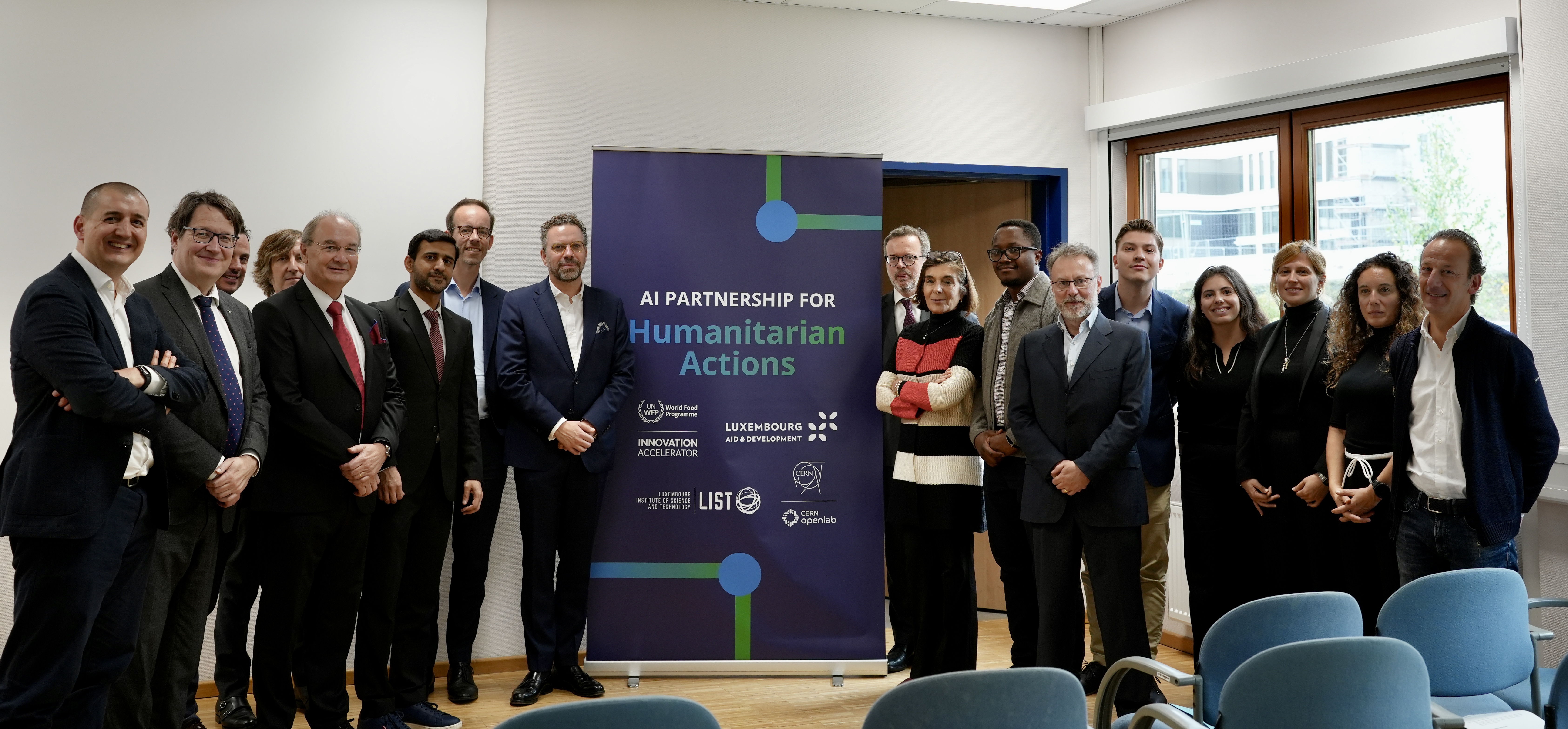
Representatives from WFP, LIST and CERN met today in Luxembourg to sign a new strategic partnership that aims to reduce world hunger. (Image: MAE Luxembourg)
A new partnership funded by the Government of Luxembourg, the United Nations World Food Programme (WFP), the Luxembourg Institute of Science and Technology (LIST) and CERN aims to use expertise in AI technology to address the issue of global hunger. The two-year strategic partnership will explore three use cases in which CERN's AI algorithms for weather modelling and prediction, as well as its expertise in distributed infrastructures, will be used together with LIST's AI for Earth observation and crop modelling. These technologies will be harnessed to amplify WFP's impact by increasing the efficiency and effectiveness of its emergency response and development activities.
The partnership is funded by the Government of Luxembourg as part of the country's development cooperation strategy and humanitarian emergency relief efforts. "In the face of multiple intersecting emergencies and disasters that are plunging the world into a deepening global hunger crisis, rethinking our approaches to dealing with humanitarian crises has become a necessity. I am proud that Luxembourg's expertise, knowledge and leadership in promoting AI can make a significant contribution to this unique partnership, which aims to foster cutting-edge technologies to accelerate progress toward a world without hunger and enhance humanitarian action worldwide", says Xavier Bettel, Deputy Prime Minister and Minister for Development Cooperation and Humanitarian Affairs, Luxembourg.
WFP helps food-insecure communities to prepare for, respond to and recover from climate shocks and stresses. It also implements climate and civil infrastructure risk management solutions in 42 countries, benefitting more than 15 million people. "This collaboration allows us to leverage responsible AI to transform our field operations, providing country offices with cutting-edge tools to make data-driven decisions in real time," says Rania Dagash-Kamara, Assistant Executive Director for Partnerships and Innovation at WFP. "By integrating Luxembourg's commitment to innovation, CERN's technological expertise and LIST's Earth observation capabilities, we are setting a new standard for humanitarian response that can save lives and enhance food security for communities in crisis."
The first use case for WTF's partnership with CERN and Luxembourg proposes to extend the WFP SKAI platform, a tool developed with Google Research that uses AI and satellite imagery to enable real-time insights and actionable intelligence for effective decision making during disaster response. The goal is to enhance the platform with improved object detection, support for more data types, and better reliability, scalability and performance and to integrate short- and medium-term weather modelling and forecasting capabilities. The existing and new technologies being developed by CERN, LIST and WFP will be combined to form a "multimodal digital twin" proof-of-concept. This will use image and sensor data with AI-based simulations, moving towards decision support systems that use data from different domains. "LIST is honoured to take part in this strategic collaboration with the World Food Programme and CERN in AI for Earth observation and crop modelling to support humanitarian aid agencies", says Lucien Hoffmann, Science Director at LIST. "LIST brings its recognised expertise in integrating Earth observation data with in-situ measured data, land surface models and satellite and terrestrial communication services in order to provide evidence-based decision support tools in near real time for one of humanity's greatest challenges related to food security."
A second use case proposes to adapt the CERN multiformat anomaly detection algorithms used for physics data monitoring and analysis to the WFP cash-based transfer system. Cash-based transfers constitute 35 percent of all WFP assistance, making WFP the world's largest provider of humanitarian cash. WFP sends money to people in need to save them from having to make impossible trade-offs, like deciding to eat less so that they can keep their children in school. The CERN anomaly detection algorithms could provide a tool for the early detection of cash transfer misuse.
To support secure and reliable data processing in the first two use cases, a third use case proposes to adapt the CERN federated learning platform (currently used in healthcare) to enable the training of AI models using data from multiple organisations for a broad range of applications. These will be defined by WFP and other organisations currently looking for secure ways of processing sensitive data.
"CERN has a long tradition of excellence and over the years has developed strong AI capabilities and competencies to enable its cutting-edge scientific research programme," concludes Enrica Porcari, Head of the IT department at CERN. "This partnership confirms once more CERN's role in fostering collaborations that address common challenges and contribute to transfer knowledge from science to society to create a positive impact for future generations."






